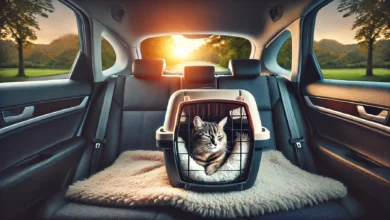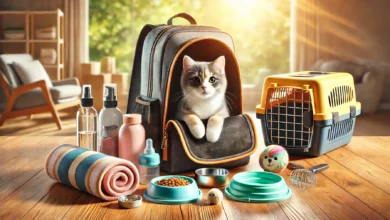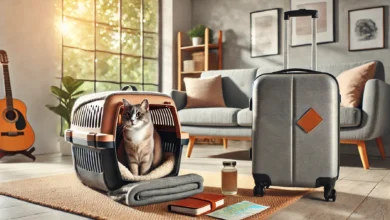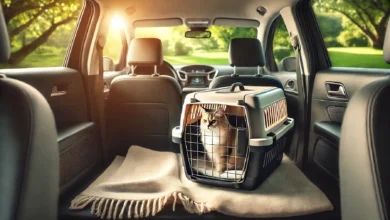How to Keep Cats Safe During Road Trips
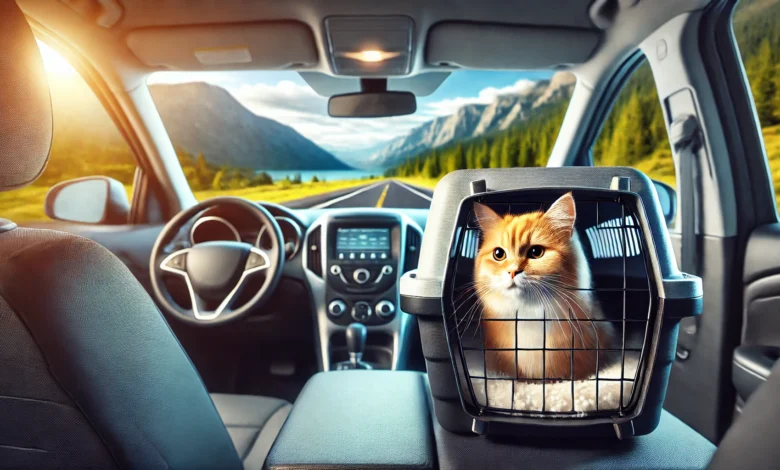
While road trips can be a great adventure, once your cats are traveling with you, you need to make sure that they will be safe and comfortable throughout the journey.
Cats are creatures of habit, and being confined in a moving vehicle for extended periods can stress them out.
That is why taking proper precautions before hitting the road is so crucial to their safety.
In this article, we will show you how to keep your cats safe during a road trip without ruining your travel.
Table of Contents
How to Prepare Your Cat for a Safe Road Trip
Preparing for a road trip with your cat is critical to making the trip smooth and safe for both of you.
In preparing your feline companion for the long drive, several steps should be put into consideration before embarking on the journey, ranging from how to choose the proper cat carrier to visiting the vet.

Choosing the Right Cat Carrier
First and foremost, choosing the right cat carrier is the most crucial part of road trip preparation.
A safe, comfortable carrier will ensure your cat is secure en route.
Not all cat carriers are made equal, and you need to choose the one that best fits the needs of your cat and your travel plans.
- Size matters: It should be large enough to allow your cat to stand, turn around, and lie down comfortably, but not too large, as this extra space may make your cat feel insecure.
- Ventilation: The carrier should have enough ventilation so your cat can breathe comfortably and avoid overheating during transport.
- Security: Look for a carrier with a secure latching or zippering mechanism to prevent your cat from attempting an escape on the road.
- Sturdiness: A hard-sided, solidly constructed carrier will offer additional safety in case of sudden stops or accidents.
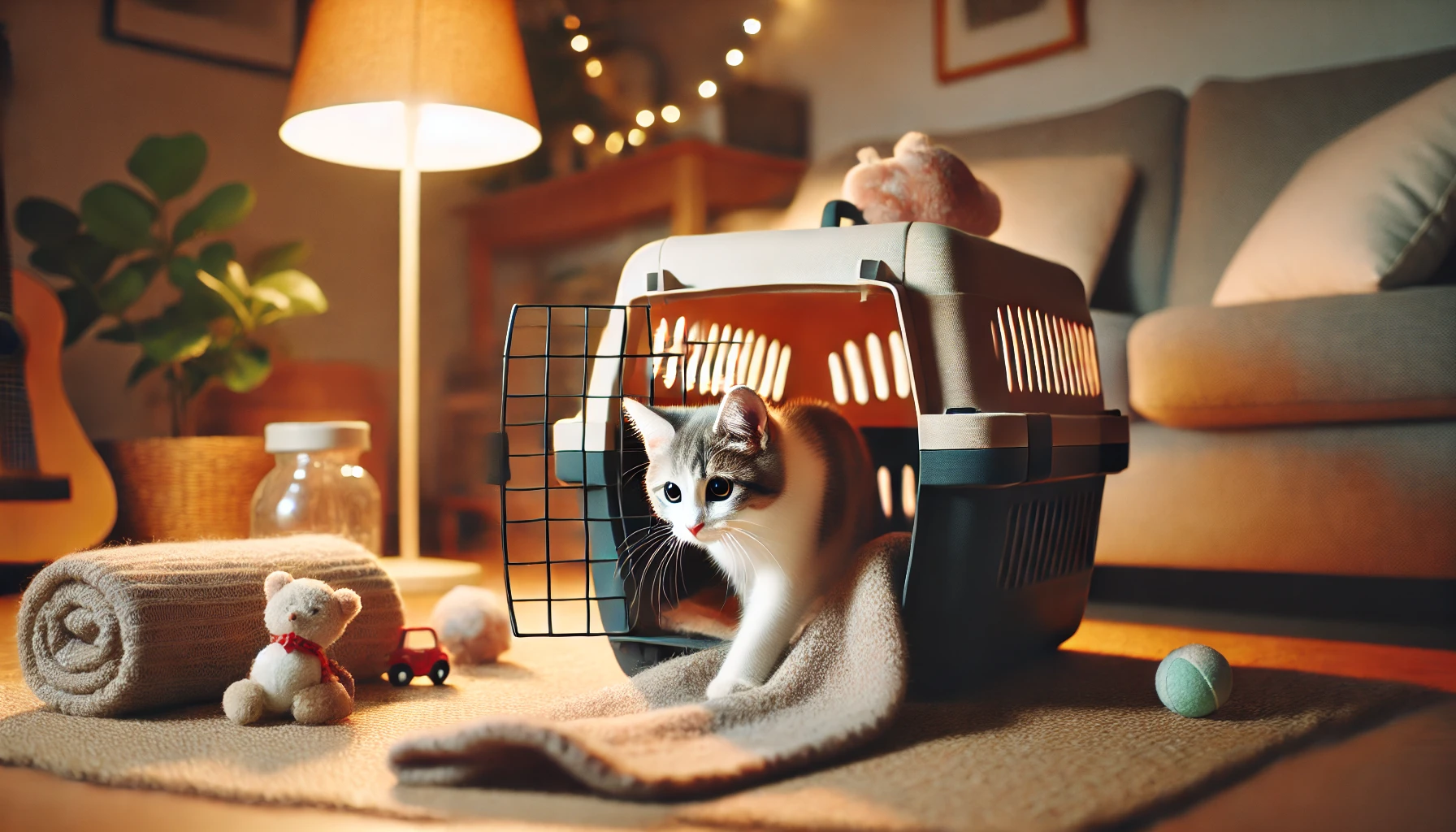
Getting Your Cat Used to the Carrier
It is very important that your cat gets used to the carrier before the road trip.
This will prevent unnecessary anxiety for your cat during travel time when they are unaccustomed to being confined.
You can start by leaving the carrier out at home, so your cat can explore it in their comfort zone.
- Invite exploration: Place your cat’s favorite toys or a blanket with their scent inside the carrier to make it more inviting.
- Short practice trips: Take your cat on short drives in the carrier to help them get accustomed to being in the car. Gradually increase the time spent in the car to build comfort.
- Reward with treats: Reward your cat with treats for staying inside the carrier each time to reinforce positive behavior.
Ensure proper preparation to keep your cat safe and calm during a road trip. Choose the right carrier and visit the vet before the journey.
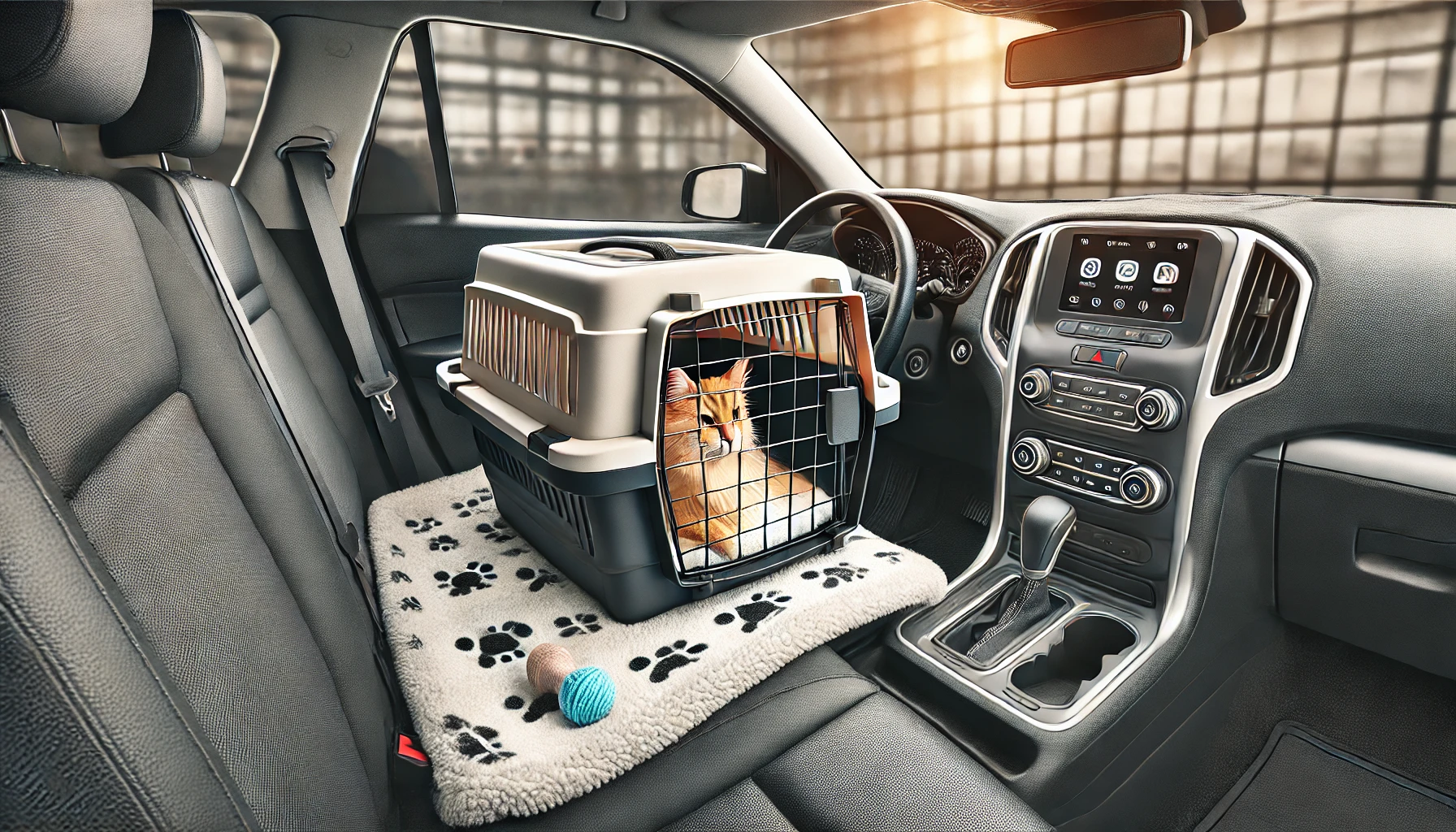
Setting Up a Comfortable Travel Environment for Your Cat
After getting your cat ready for travel, your next task is to set up a safe and comfortable zone in the car for them.
Traveling with a cat can get quite difficult if they become nervous, so making them feel secure is a must during trips.
How well your cat copes with the road trip, and how little it will distract you from driving, depends a great deal on a calm and comfortable space.
Here are some ways to create an optimal travel environment to keep your cats safe during the journey.
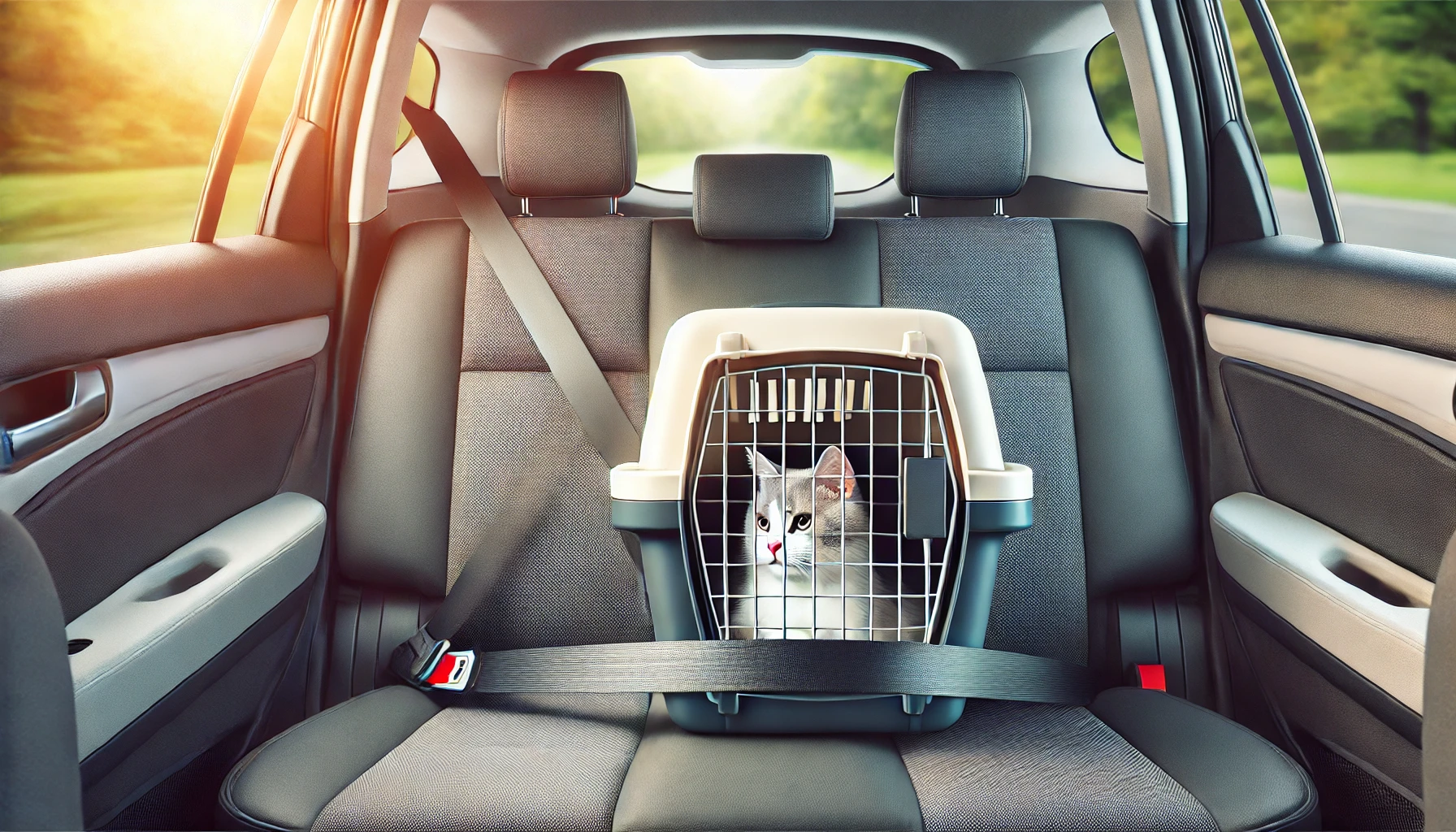
Securing the Carrier in Your Car
One of the most critical aspects is securing the carrier properly.
You need to place it in a safe and stable position so it will not shift while the car is in motion.
This way, sudden movements will not stress out your cat.
- Place the carrier on the back seat: The rear seat is the safest place for your cat during the journey. Fix the carrier with a seatbelt to prevent it from shifting during sudden stops or turns.
- Avoid the front seat: Never place the carrier in the front seat, as airbags can pose a serious risk to your cat in the event of an accident.
- Use a non-slip mat: Placing a non-slip mat underneath the carrier can add extra stability and comfort for your cat, preventing it from sliding around during the trip.
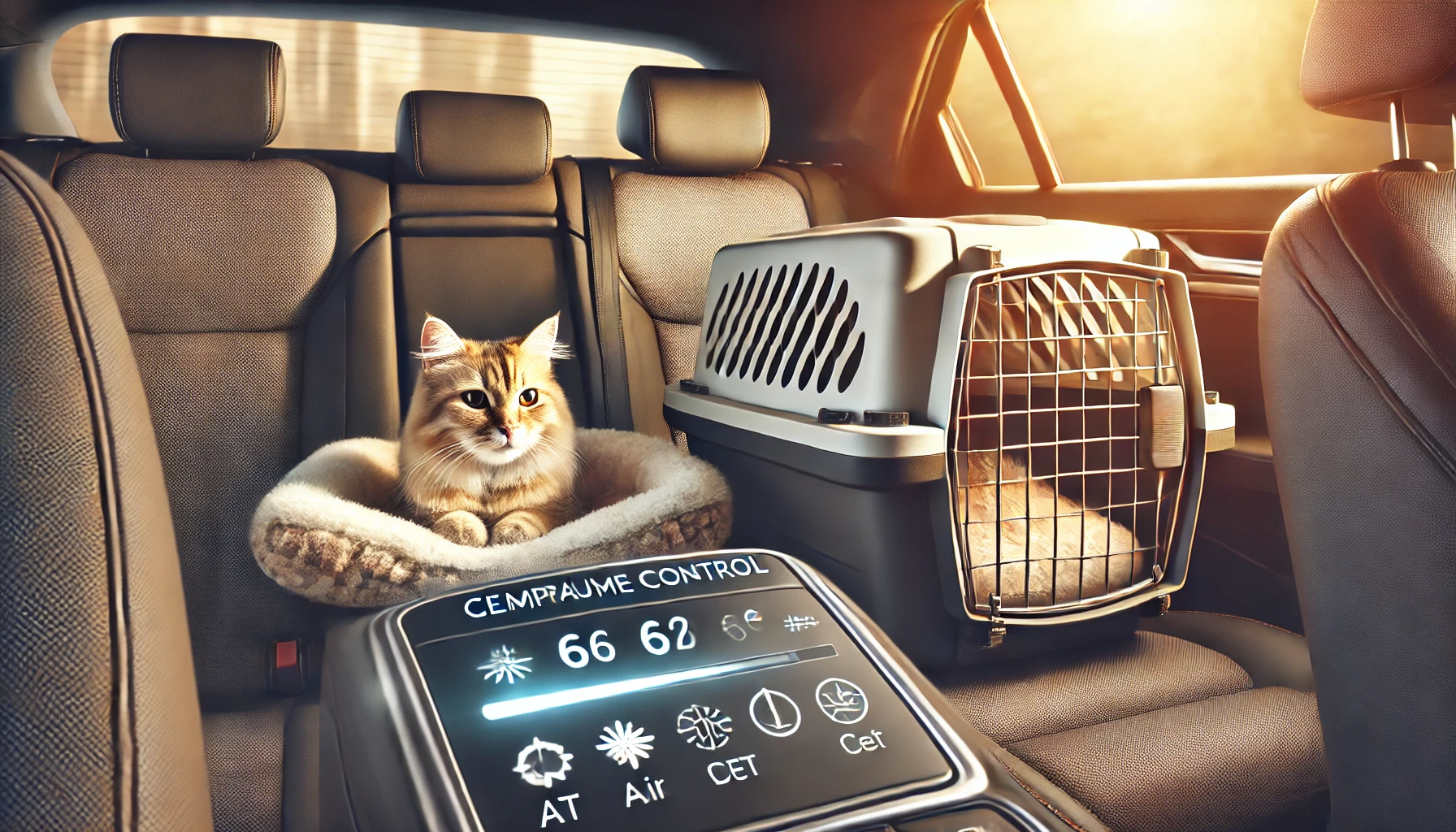
Temperature Regulation for Your Cat’s Comfort
Cats can be quite sensitive to temperature changes, so it is essential to maintain an appropriate temperature inside the car.
Whether you are traveling in summer or winter, making sure your cat is neither too hot nor too cold is crucial for their comfort.
- Use the car’s climate control: Keep the air conditioning or heating at a moderate temperature between 65°F and 75°F (18°C to 24°C) to keep your cat comfortable.
- Keep the car well-ventilated: Ensure there is good ventilation, but avoid direct airflow on the carrier, as it may cause discomfort for your cat.
- Avoid extreme temperatures: Never leave your cat in a parked car, especially in hot or cold weather, as this can lead to heatstroke or hypothermia.
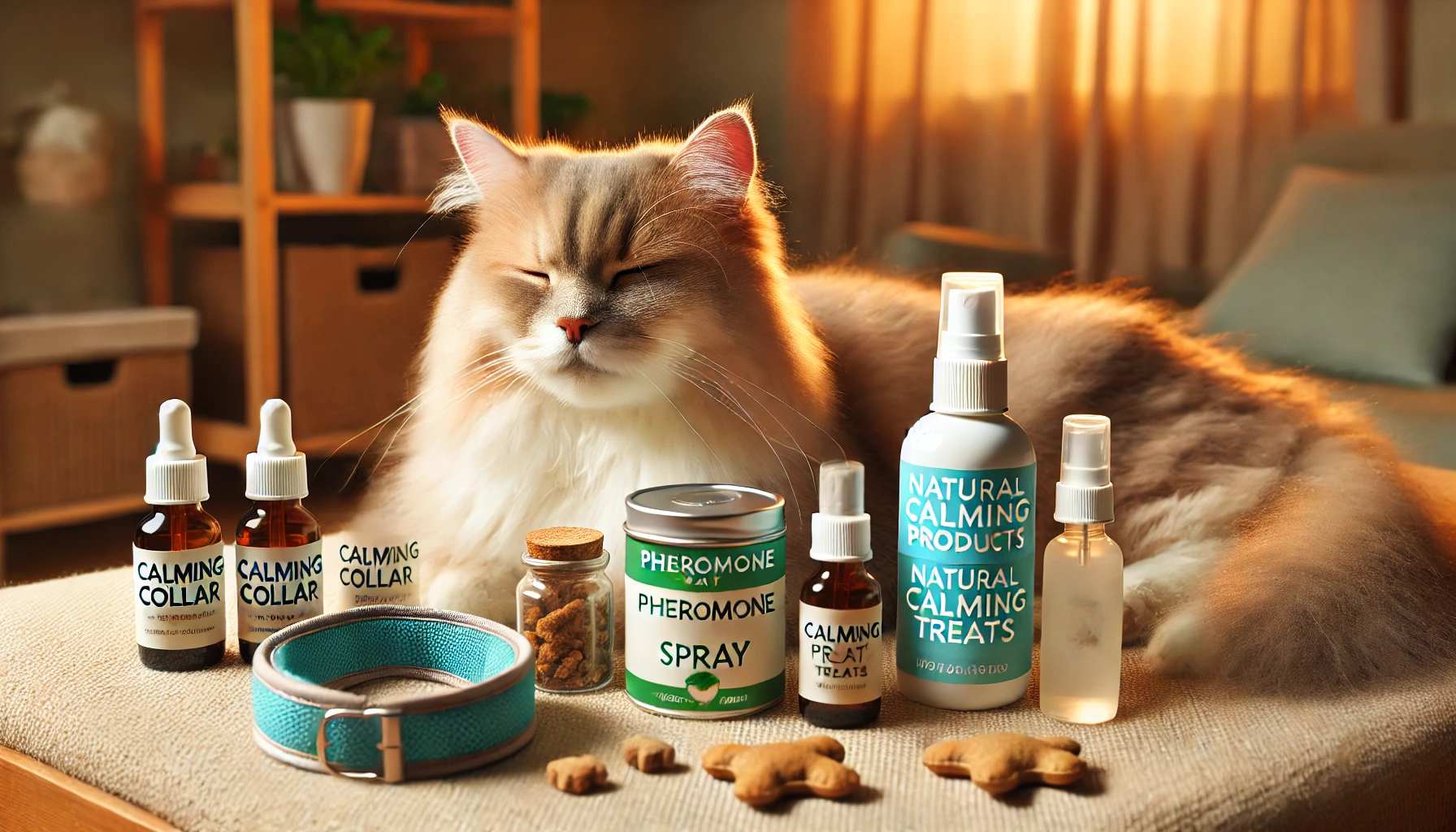
Minimizing Stress by Utilizing Calming Products
Even if everything is set up correctly, your cat may still feel a little nervous during the trip.
The following products can help reduce stress and create a more relaxing experience for your cat.
- Pheromone sprays: Spraying a synthetic pheromone product like Feliway inside the carrier can help calm your cat and reduce anxiety.
- Calming collars: Calming collars infused with natural ingredients such as lavender and chamomile can help soothe your cat during travel.
- Herbal supplements: Natural calming supplements for pets that contain ingredients like L-theanine or tryptophan can be given to your cat before the journey to reduce stress.
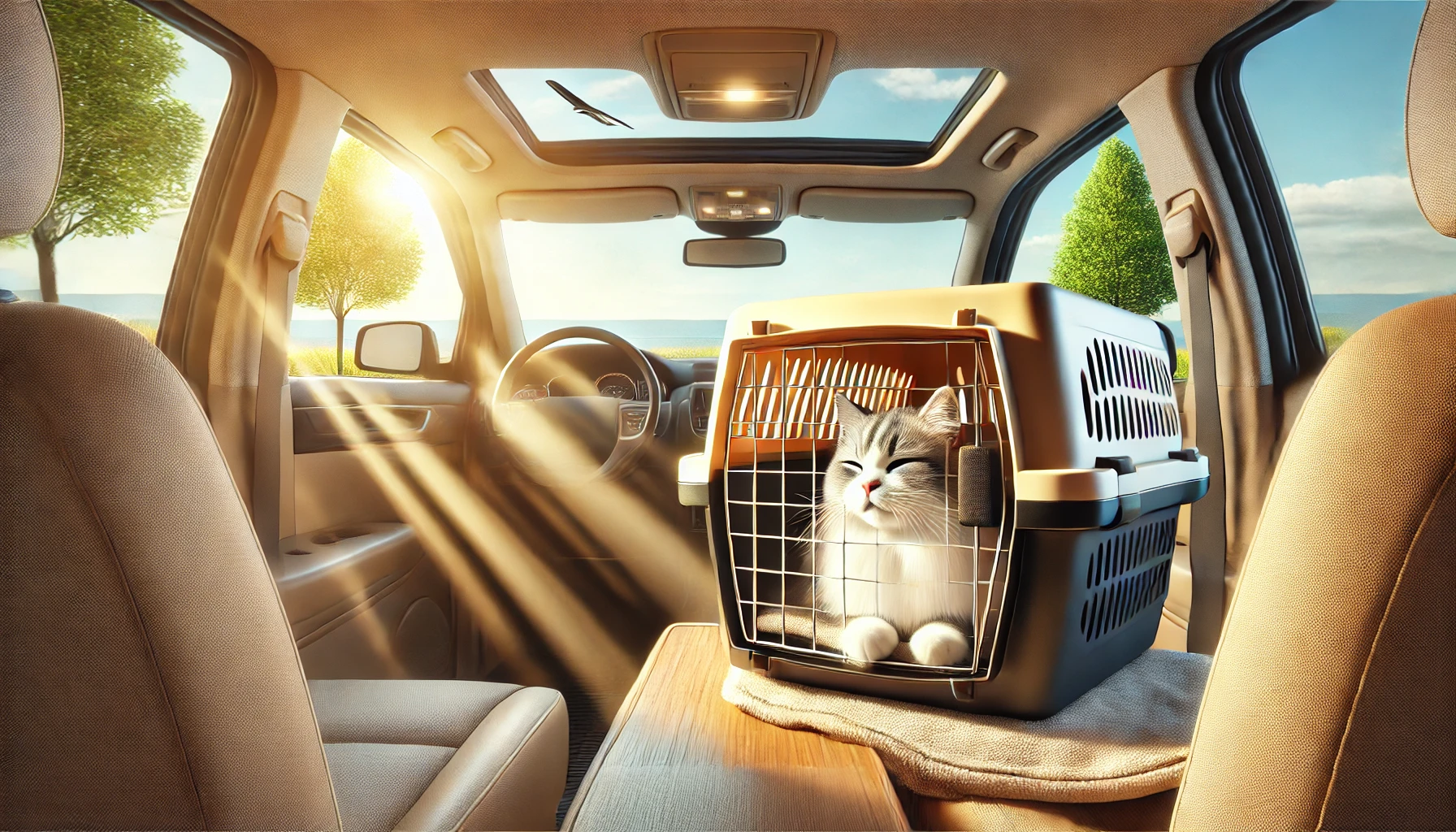
Maintaining Ventilation and Fresh Air
It’s important that your cat has access to fresh air during the trip.
Good ventilation can help keep your cat calm and prevent motion sickness or overheating.
- Open windows slightly: If the weather is suitable, you can slightly open the windows to allow fresh air in, but ensure your cat is securely inside the carrier.
- Check car airflow: Place the carrier in an area where the air circulates freely, but avoid placing it directly in front of air vents or fans.
Creating a calm and secure travel environment will help reduce stress for your cat during the trip. Secure the carrier and regulate the temperature inside the car.
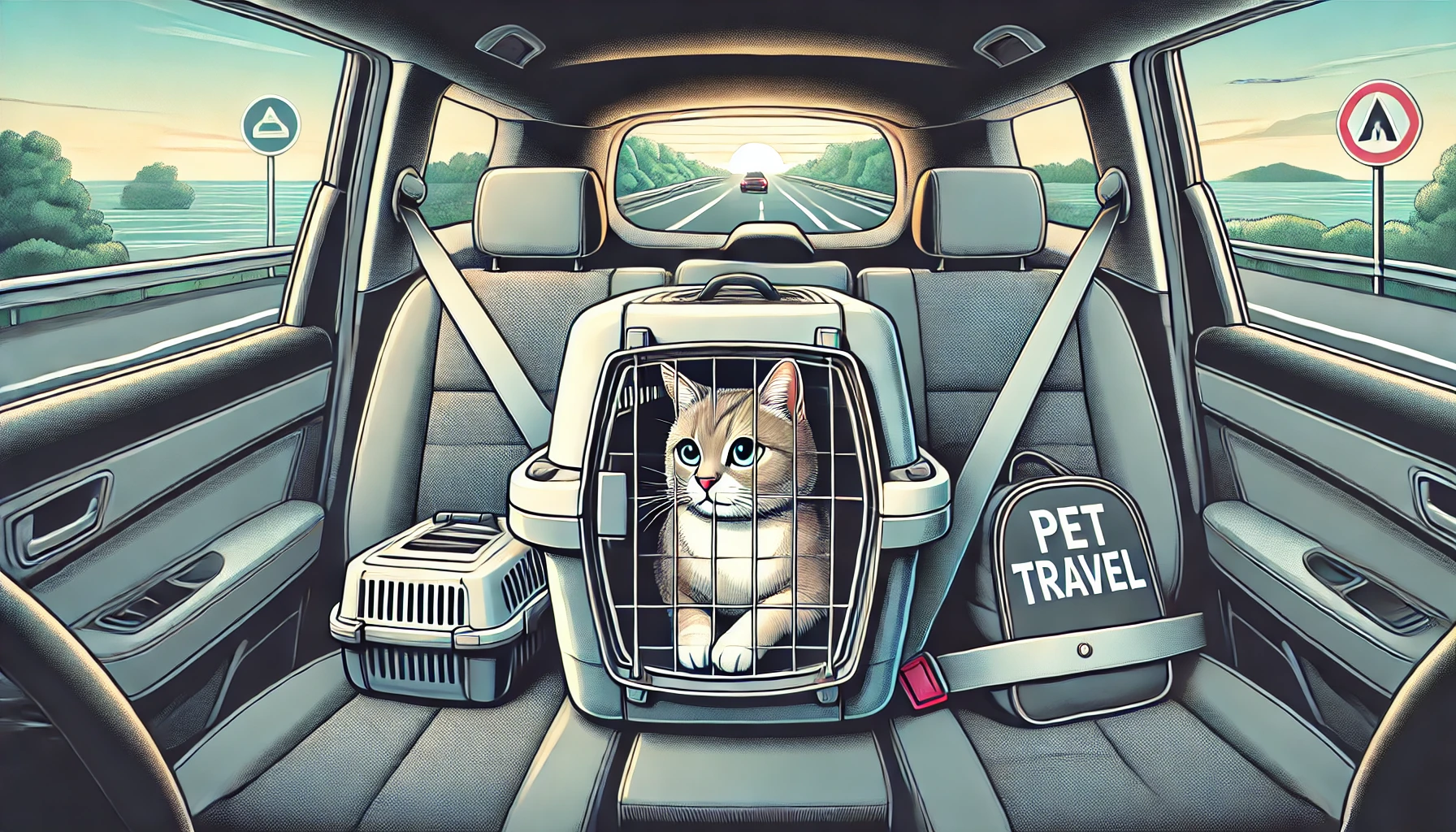
Keeping Your Cat Safe on the Journey
Now that your cat is comfortable and the travel environment has been set up, the next steps focus on safety while traveling.
Road trips can be unpredictable, and you want to ensure your cat stays safe and secure throughout the trip.
With a little extra foresight, you can make sure your cat is calm, hydrated, and free from stress.
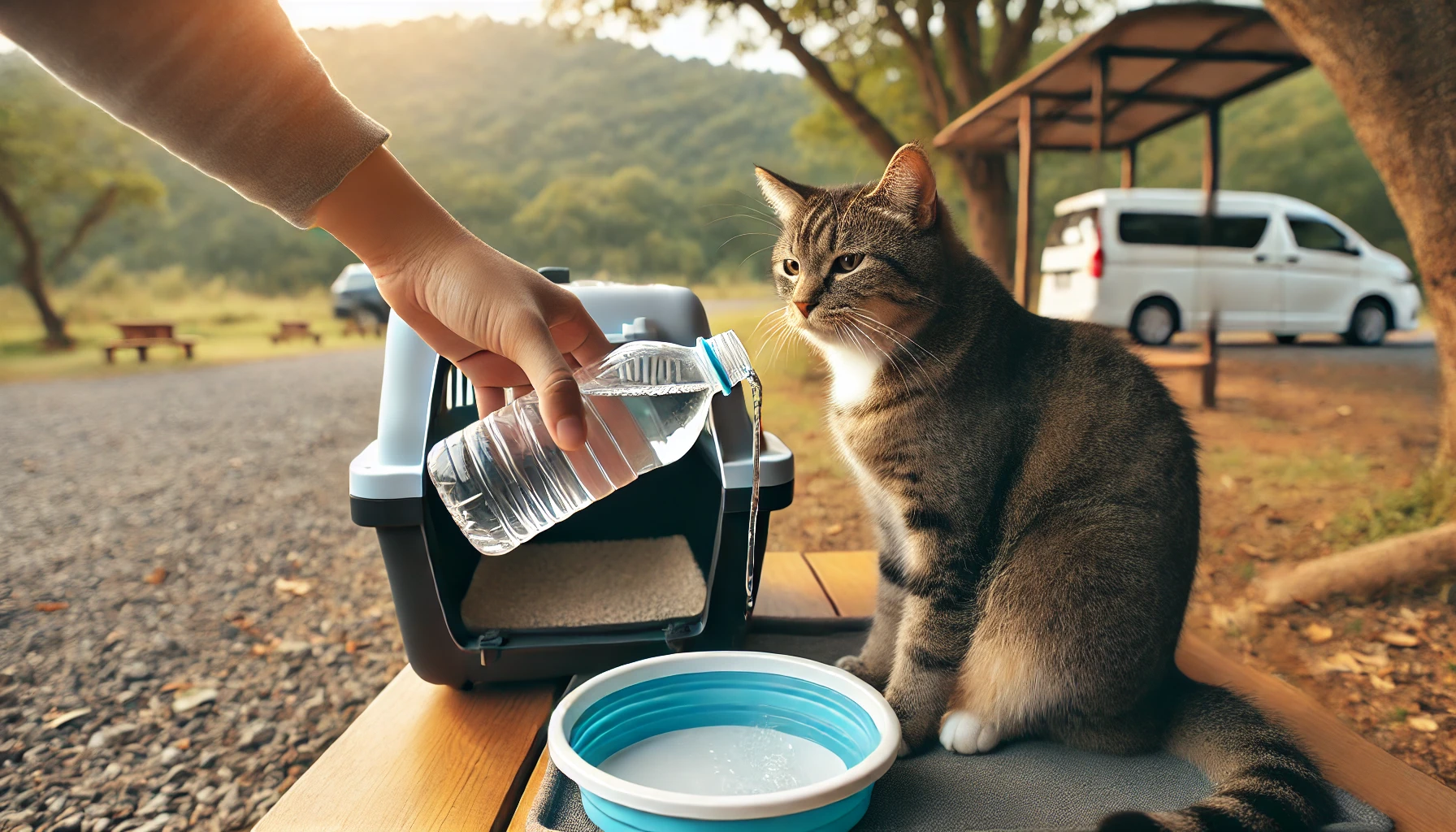
Breaking for Water and Rest
Just like humans, cats need breaks during long trips to stretch, rehydrate, and take care of their business.
Ensuring your cat has time for water and rest is vital for maintaining safety and comfort during road trips.
- Plan stops every 2-3 hours: On long drives, stop every couple of hours to give your cat some time out. They will have the chance to rehydrate, use the litter box if needed, and stretch in the carrier.
- Give water frequently: Carry a water bottle and a collapsible, shallow bowl to offer your cat water at each stop. Keep the water fresh and cool to encourage your cat to drink.
- Portable litter box: Bring a small, portable litter box on longer trips. Some cats may be hesitant to use it, but it’s always good to have in case of emergencies.
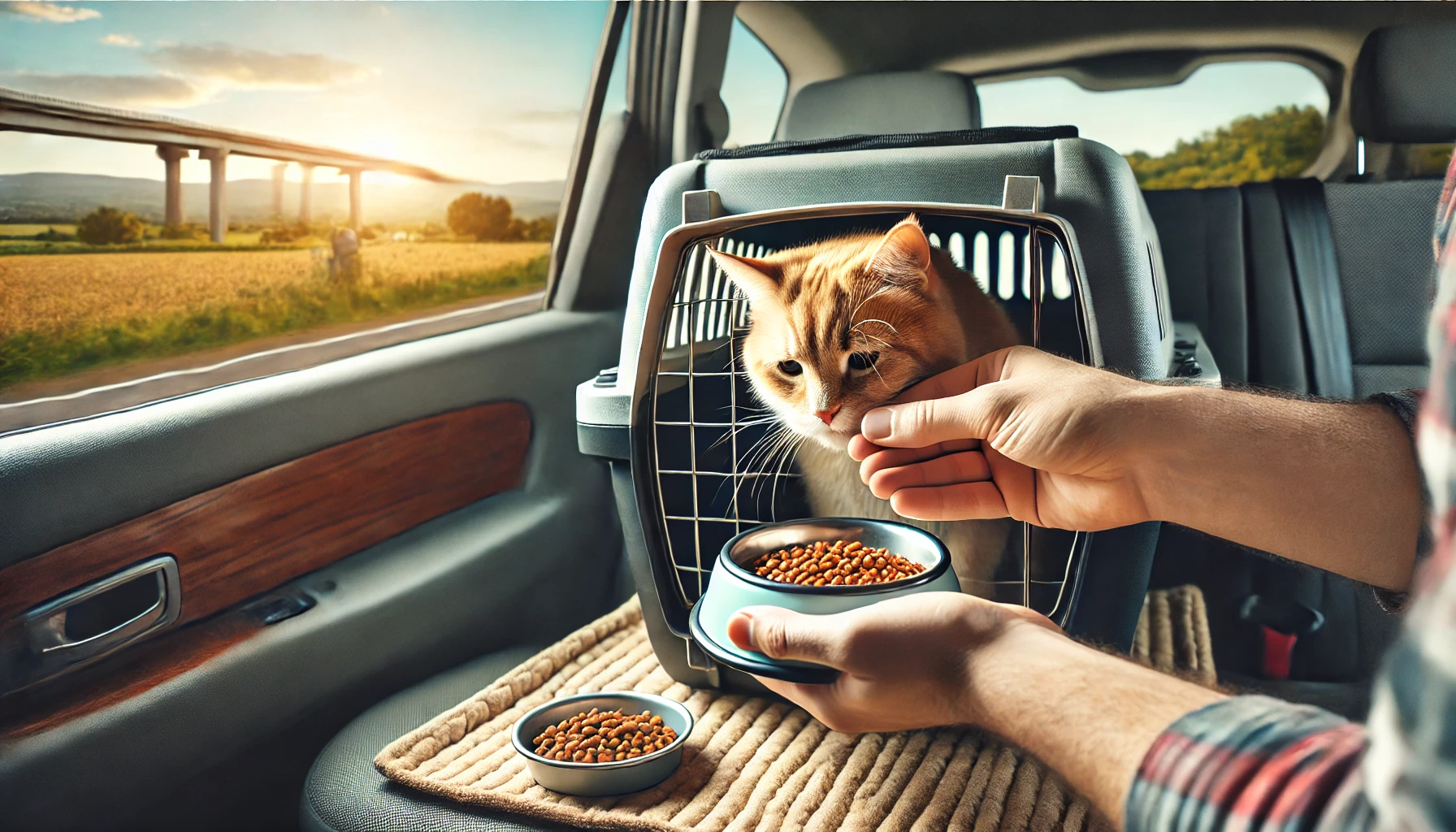
Feeding Your Cat Safely While Traveling
Feeding your cat on the road requires careful timing and portion control to avoid motion sickness or discomfort.
Here’s how to feed your cat safely so they remain comfortable during a road trip.
- Feed a light meal in advance of the journey: A few hours before the trip, give your cat a small, light meal. Allow your cat time to digest and avoid feeding immediately before loading into the vehicle to prevent motion sickness.
- Stick to your cat’s regular feeding routine: For long trips, try to feed your cat at their usual mealtimes. Use a small, collapsible food bowl for convenience.
- Do not overfeed: Overfeeding during the ride can cause stomach upset or motion sickness. Provide small portions and monitor your cat’s behavior.
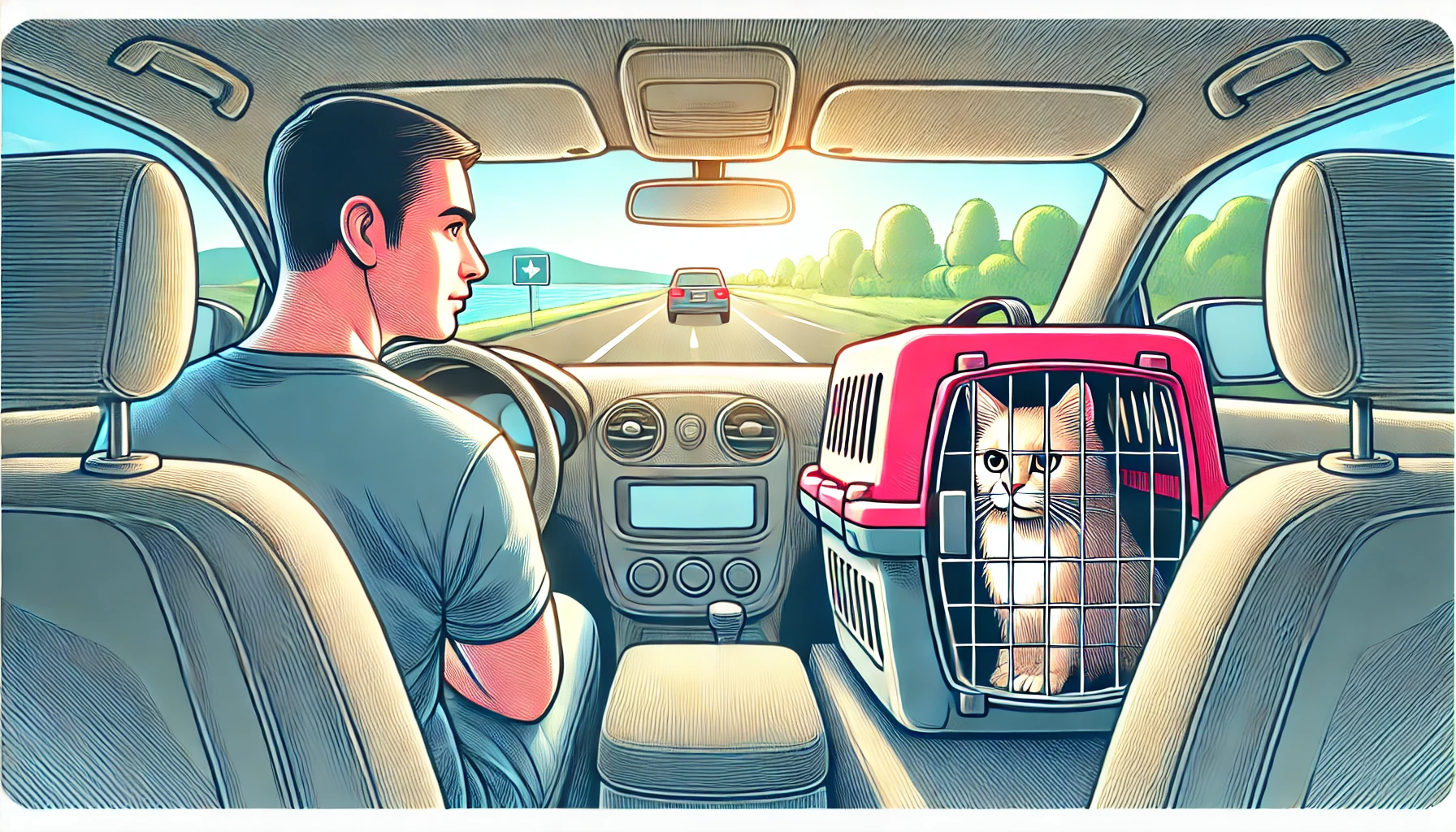
Monitoring Your Cat’s Behavior During Travel
Closely observing your cat during the journey is essential for ensuring their safety.
Some cats may show signs of anxiety or discomfort, and it’s important to recognize these signs early to make any necessary adjustments.
- Look for signs of anxiety: If your cat is panting, meowing excessively, or pacing inside the carrier, they are likely feeling stressed. Try to soothe your cat with calming words, or take a break to help them settle.
- Motion sickness: If your cat starts drooling, vomiting, or appearing unwell, these are signs of motion sickness. Ensure the car is well-ventilated and avoid bumpy driving to minimize these risks.
- Limit distractions: Loud noises, sudden movements, or too much activity in the car can increase your cat’s stress levels. Try to keep the noise level low and minimize activity whenever possible.
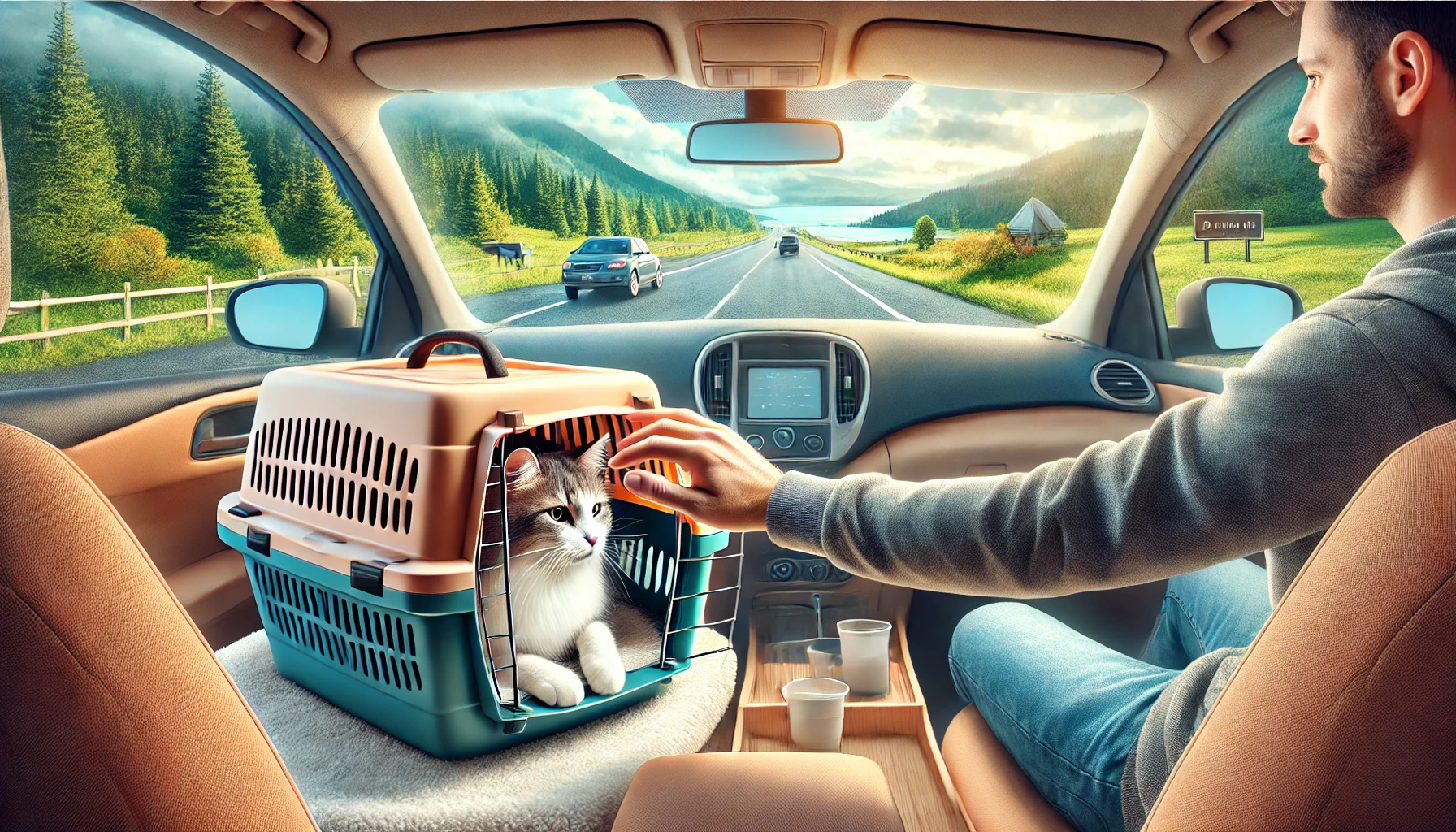
How to Handle Motion Sickness and Anxiety
Motion sickness and anxiety are common issues for cats during car rides.
Fortunately, these problems can be managed with a few steps to keep your cat safe and comfortable during the trip.
- Drive smoothly: Avoid sudden stops, abrupt turns, or speeding, as these can increase anxiety or worsen motion sickness. Try to maintain a smooth, steady pace to reduce discomfort.
- Calming aids: Use calming sprays or herbal supplements before the trip to help relax your cat. Products like Feliway can make a big difference in reducing your cat’s anxiety.
- Consult with your vet: If your cat suffers from severe motion sickness, your veterinarian may be able to recommend medication or offer advice on how to make the journey easier for your cat.
Plan regular breaks for hydration and rest. Keep an eye on your cat’s behavior to spot any signs of stress or discomfort during the journey.
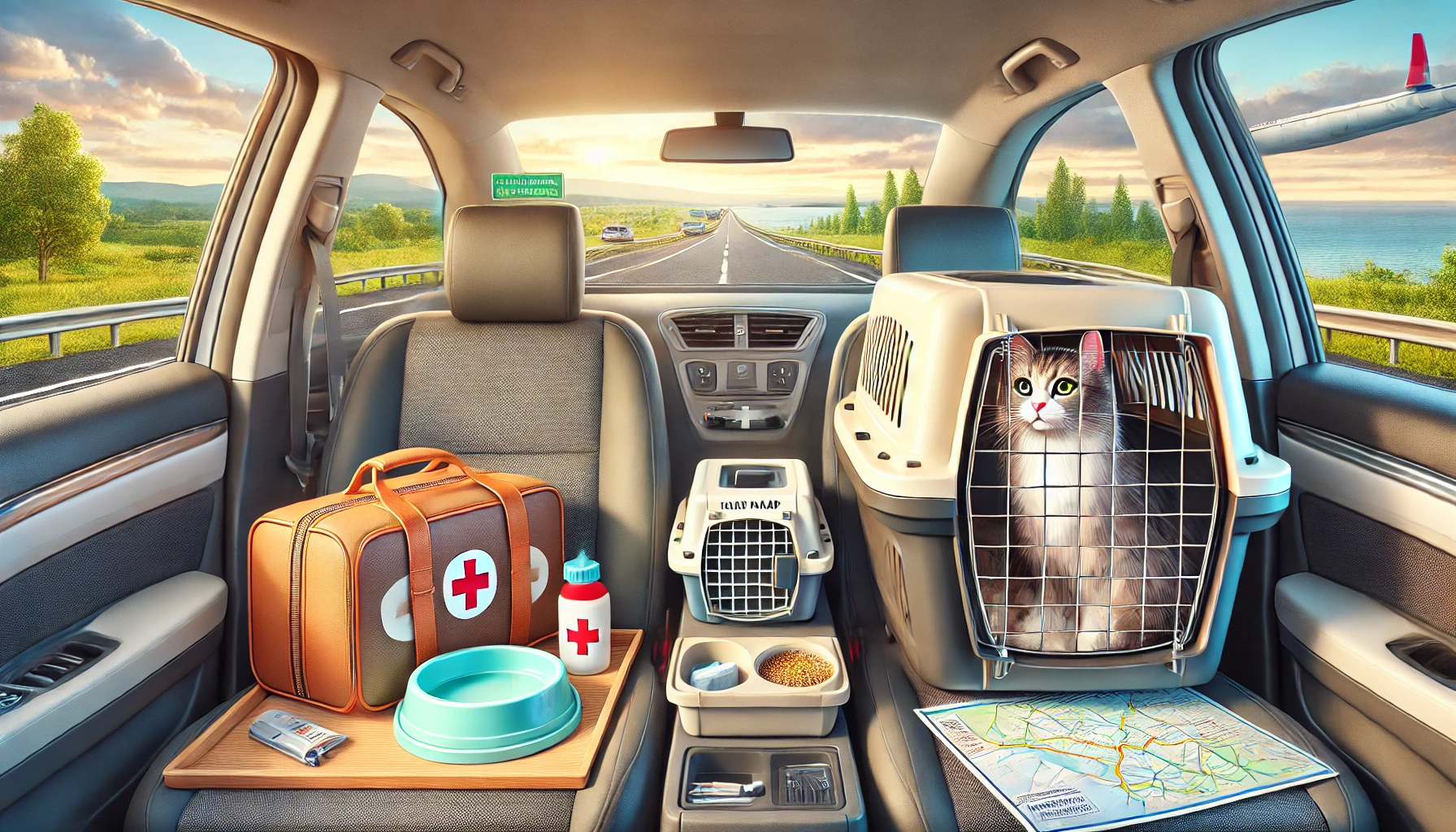
Safety Tips for Road Trips Over Long Distances with Cats
Long-distance road trips with cats require more planning to ensure their comfort and safety.
Longer trips may include overnight stays, changing environments, and more hours spent in the car.
To keep your cats safe during such a long road trip, you need to prepare for any eventuality, including rest stops or emergencies.
By following these tips, you’ll make sure your feline friend stays safe and relaxed throughout the journey.
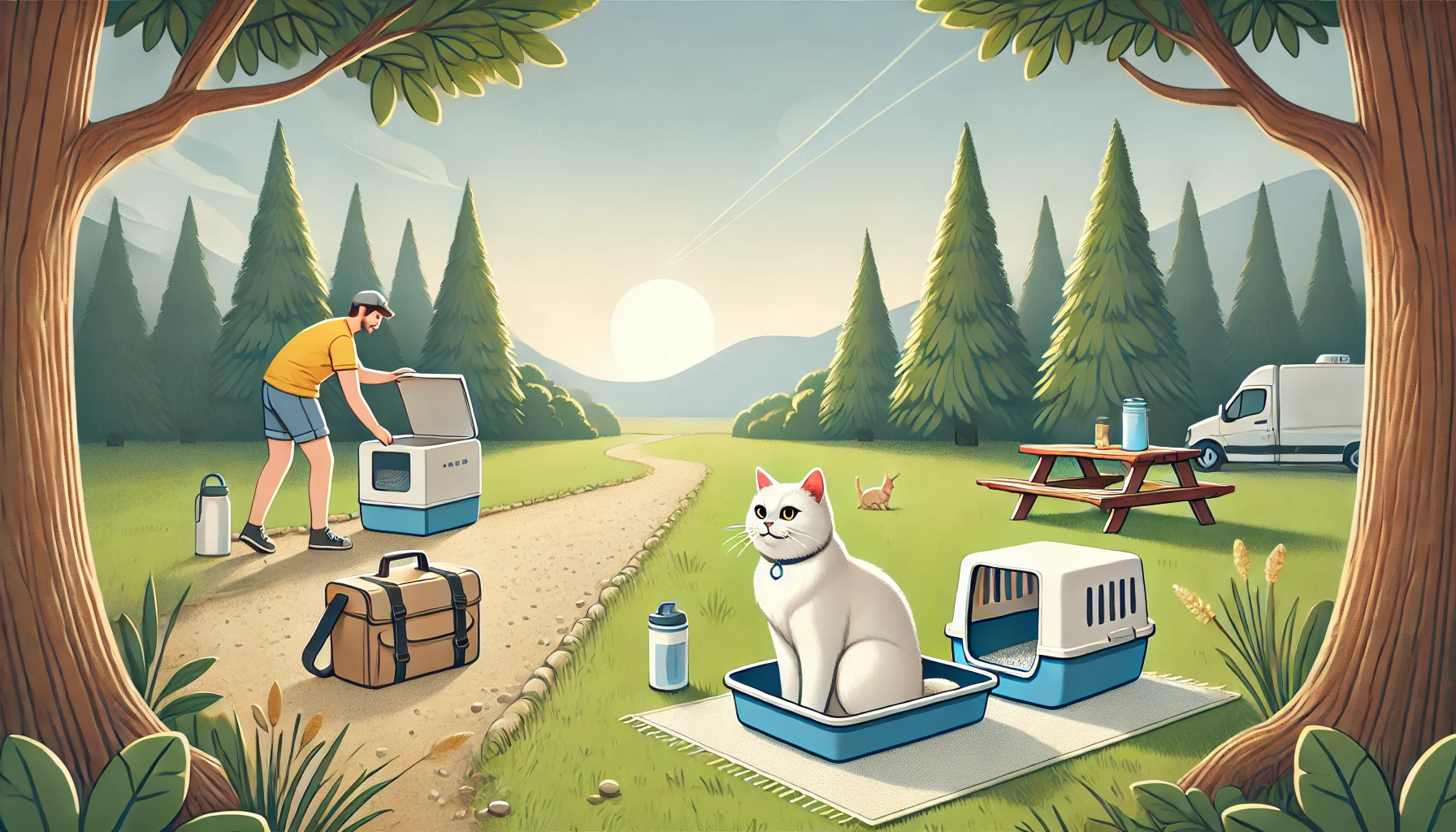
Planning Rest Stops for the Comfort of Your Cat
The best way to handle road trips is by planning places where you can stop and let your cat rest outside the car.
Cats can get restless after spending too much time in a confined space, and breaks help them stay calm and hydrated.
- Schedule regular stops: Try to stop every 2-4 hours to give your cat a chance to rehydrate, stretch, and use the litter box. During these breaks, choose rest stops in quiet and safe areas for your pet.
- Bring all essentials: Take a portable litter box, water, and your cat’s favorite blanket or toy to make them feel comfortable during rest stops.
- Supervised walks: If your cat is leash-trained, consider taking them for a short walk in a safe and quiet area to stretch their legs.
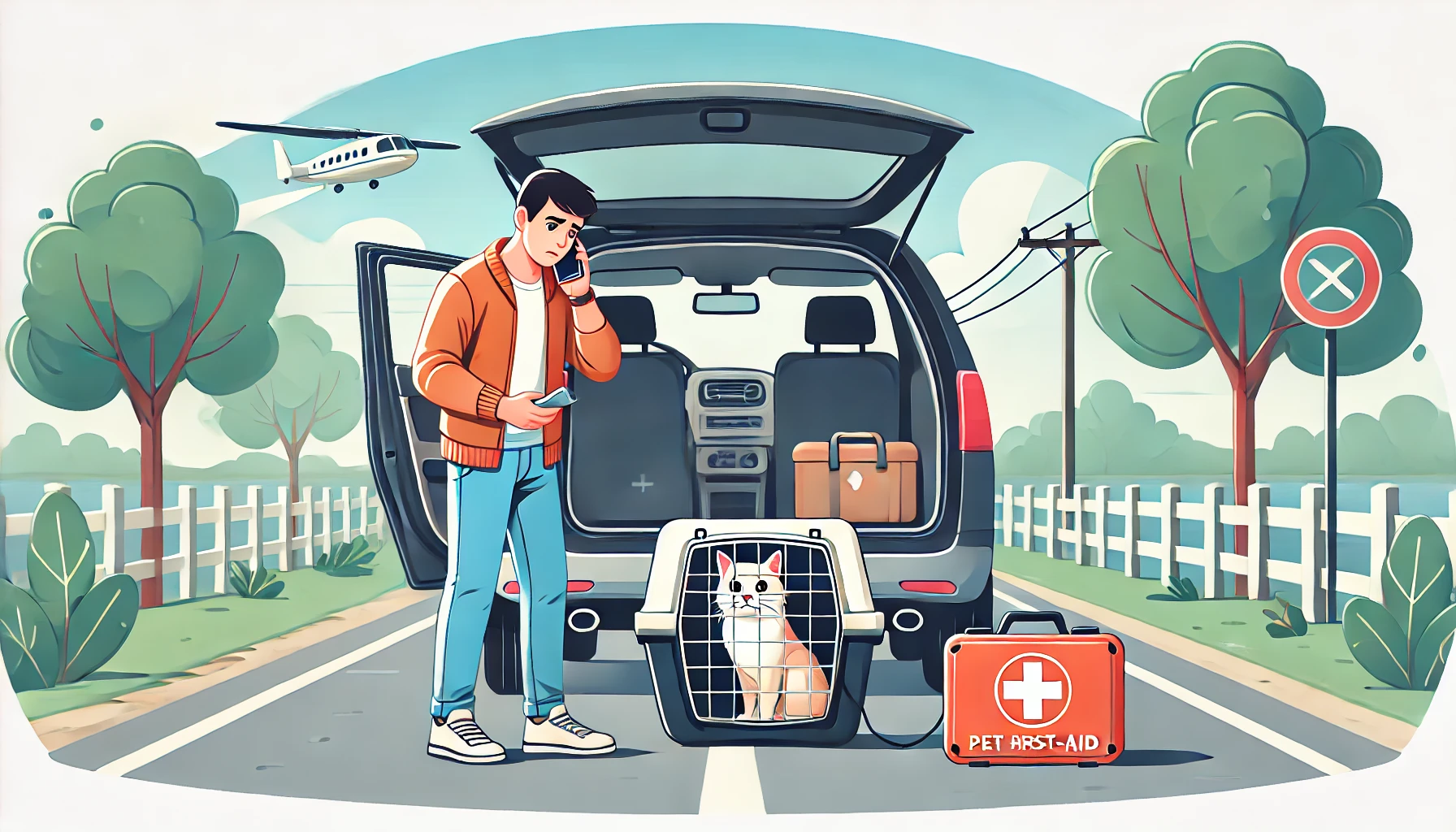
Handling Emergencies on the Road
Emergencies can happen at any time, and being prepared to handle them will ensure that, if anything goes wrong during the long drive, you are ready to take action.
Whether it’s a health issue, car trouble, or an unexpected delay, having a plan helps keep your cat safe.
- Take a first-aid kit for your cat: Pack basic supplies, such as antiseptic wipes, gauze, tweezers, and your cat’s prescription medication. Learn some basic pet first aid in case of minor injuries.
- Know where the nearest vet is: Before the journey, research veterinary clinics along your route in case you need to make an emergency stop. Always carry their contact details with you.
- Be prepared for delays: Bring more food, water, and litter than you think you’ll need in case of unexpected delays.
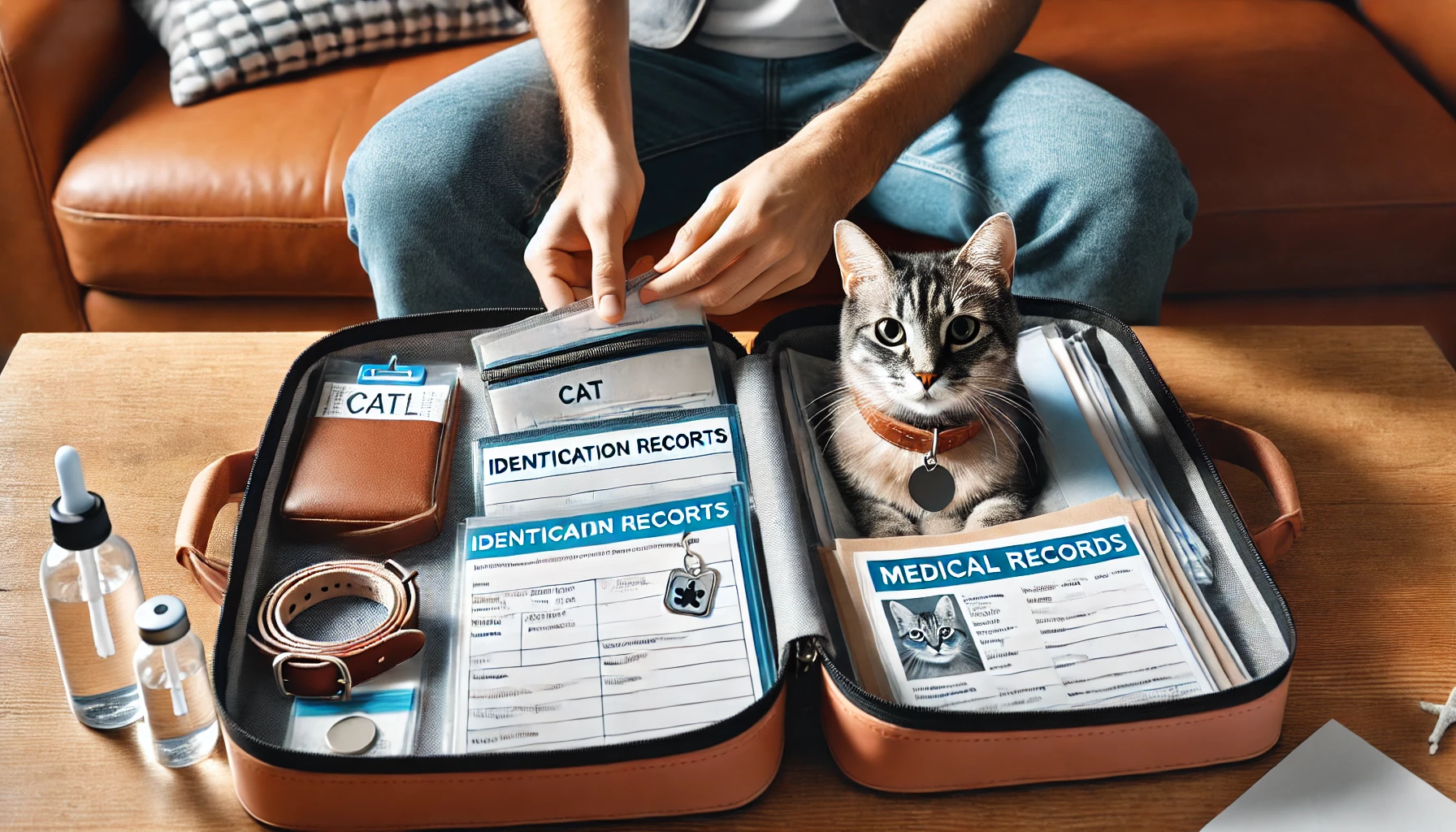
Identification and Medical Records at Hand
Having proper identification for your cat and keeping their medical records accessible can prove to be very valuable during a long journey.
If something happens, you will have all the necessary information to get help right away.
- Ensure your cat is wearing updated identification tags: Put a collar on your cat with a clear identification tag containing your contact information. Microchipping is also recommended for added security.
- Carry vaccination and medical records: Bring a copy of your cat’s vaccination record and medical history, especially if you are crossing state borders or staying in pet-friendly accommodations.
- Use a travel-friendly carrier: Some carriers have compartments for storing documents, making it easier to access them when needed.
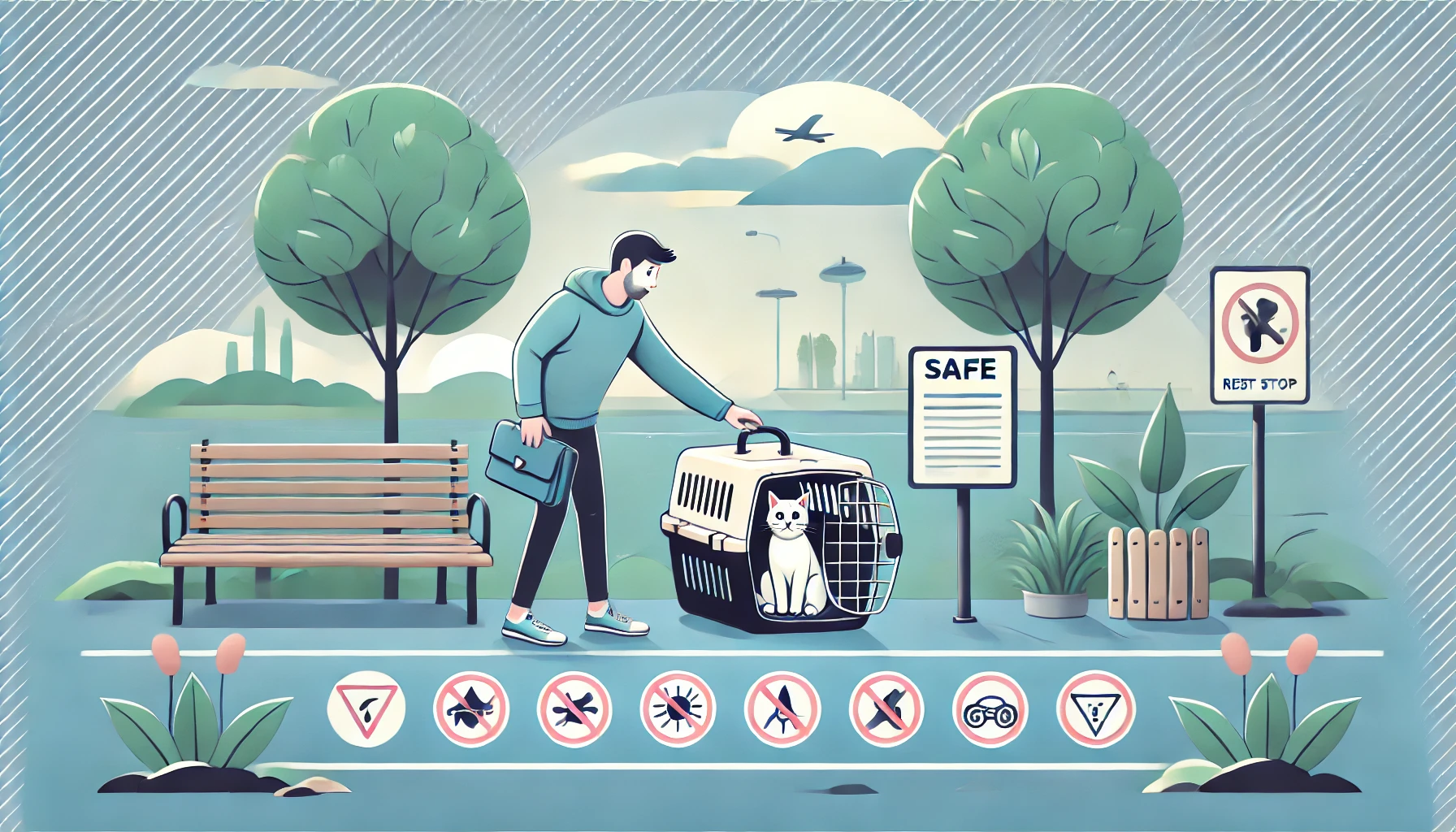
Avoiding Common Travel Dangers for Cats
There are several hazards your cat could face during long car trips, and knowing about them in advance can help prevent accidents or harm.
By planning ahead and taking precautions, you can avoid most risks and keep your cat safe during the journey.
- Keep the windows shut: Even if your cat is in a carrier, keeping the windows closed prevents escape attempts and exposure to potentially harmful elements.
- Don’t leave your cat alone: Never leave your cat unattended in the car, especially in extreme temperatures. Cars can heat up quickly, putting your cat at risk of heatstroke or hypothermia.
- Beware of toxic plants or hazards: At rest stops, avoid letting your cat near toxic plants or hazardous substances such as antifreeze, fertilizers, or insecticides.
Long trips require extra planning. Ensure frequent stops and bring essential supplies to make your cat’s journey as comfortable and safe as possible.
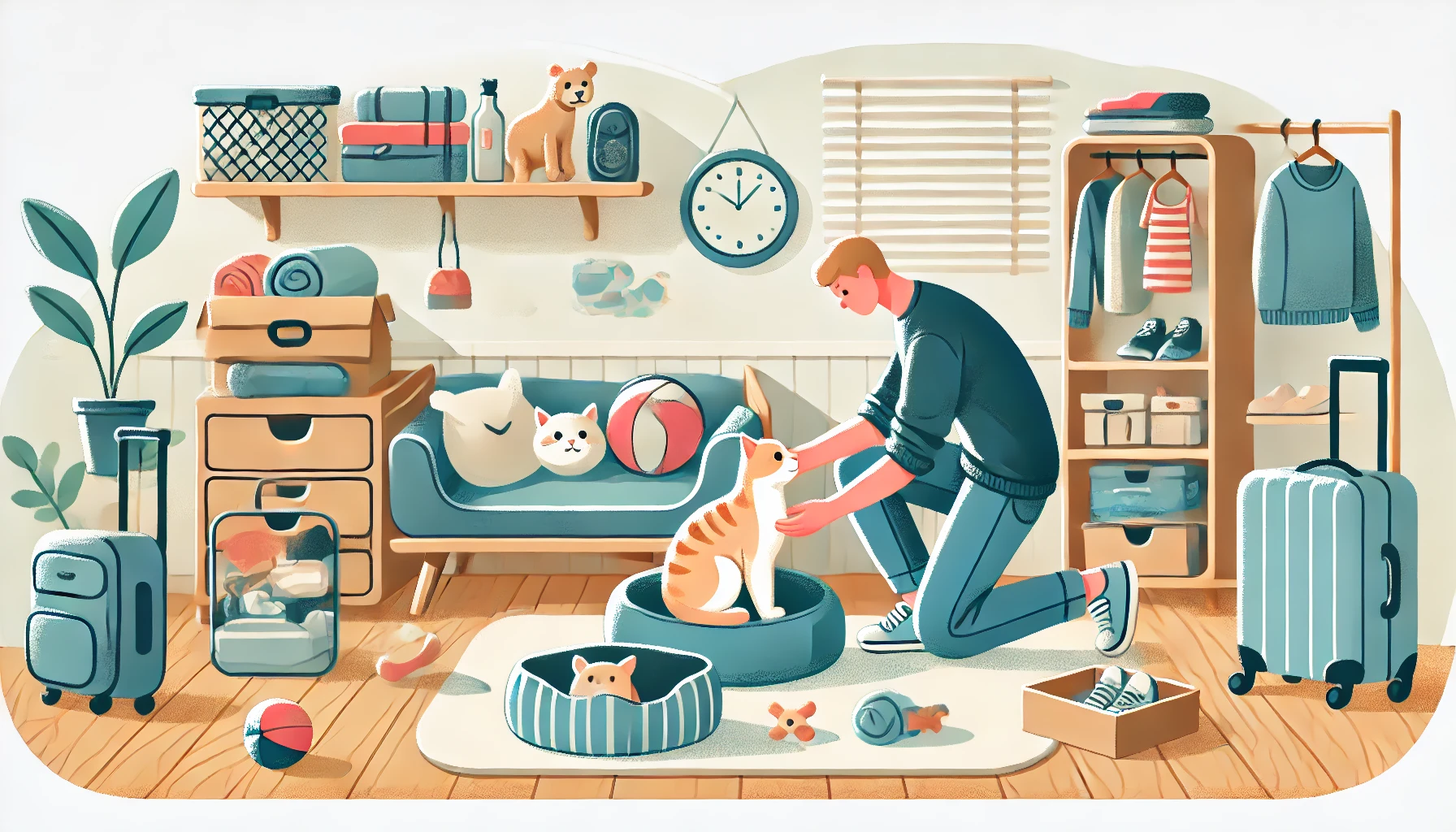
After the Road Trip: Helping Your Cat to Settle In
Once you arrive at your destination, it’s a good time to help your cat adjust to the new surroundings.
Cats can be very sensitive to change, and the new sights and smells of a location may cause them stress.
Here’s how you can help your cat settle in and relax after a long road trip to keep your cat safe and comfortable.

Smoothening the Transition to a New Environment
Your cat may be puzzled by arriving in a new place after such a long journey.
It’s important to create a familiar and safe space for your cat to make the transition smoother.
- Identify and mark off a space: Set up a small, quiet room where your cat can retreat and feel safe. Place their bed, blanket, and favorite toys in this space to provide comfort.
- Time to explore: Allow your cat to explore their new surroundings at their own pace. Give them as much time as they need to leave the carrier without pressuring them.
- Keep familiar scents around: Bringing along items with familiar scents, such as blankets or toys, will help your cat feel less anxious in a new environment.

Providing Fresh Water and Food Right After the Journey
After traveling for a long time, your cat may be thirsty and hungry.
Providing fresh water and food as soon as possible is essential for helping your cat recover from the stress of travel.
- Give fresh water immediately: Upon arrival, provide clean, fresh water right away. Traveling can dehydrate your cat, so encourage them to drink.
- Feed a small meal: Avoid feeding a large meal immediately after the trip. Offer a small portion to avoid upsetting their stomach after a long journey.
- Stick to their feeding routine: Try to return to your cat’s regular feeding schedule as soon as possible to give them a sense of routine and comfort.

Checking Your Cat for Signs of Stress or Discomfort
Even if the trip went smoothly, your cat may still experience stress or discomfort upon arrival.
Monitor your cat closely to ensure they don’t need any extra care or attention.
- Watch for signs of stress: Hiding, excessive grooming, or changes in behavior are potential signs of stress. Give your cat time to adjust and provide reassurance if needed.
- Look for physical signs of discomfort: Check your cat for any signs of physical discomfort, such as limping, vomiting, or signs of illness, and consult a vet if necessary.
- Reintroduce familiar routines: Cats thrive on routine, so bringing back their usual playtimes, feeding times, and sleeping habits will help them feel more comfortable in the new environment.

Keeping Routines Consistent After the Trip
Consistency is key to helping your cat acclimate after a road trip.
Cats are creatures of habit, and sticking to their normal routines will help them feel more comfortable in their new surroundings.
- Resume daily activities: Try to return to your cat’s usual activities as soon as possible, such as playtime and grooming routines, to provide a sense of normalcy.
- Give plenty of attention: Spend extra time with your cat in the days following the trip to offer reassurance and comfort.
- Monitor their behavior: Keep an eye on your cat’s behavior during the first few days after arrival to ensure they’re settling in well and not showing signs of continued stress or anxiety.
Help your cat adjust to the new environment by creating a familiar and comfortable space. Keep their routines consistent for a smooth transition.
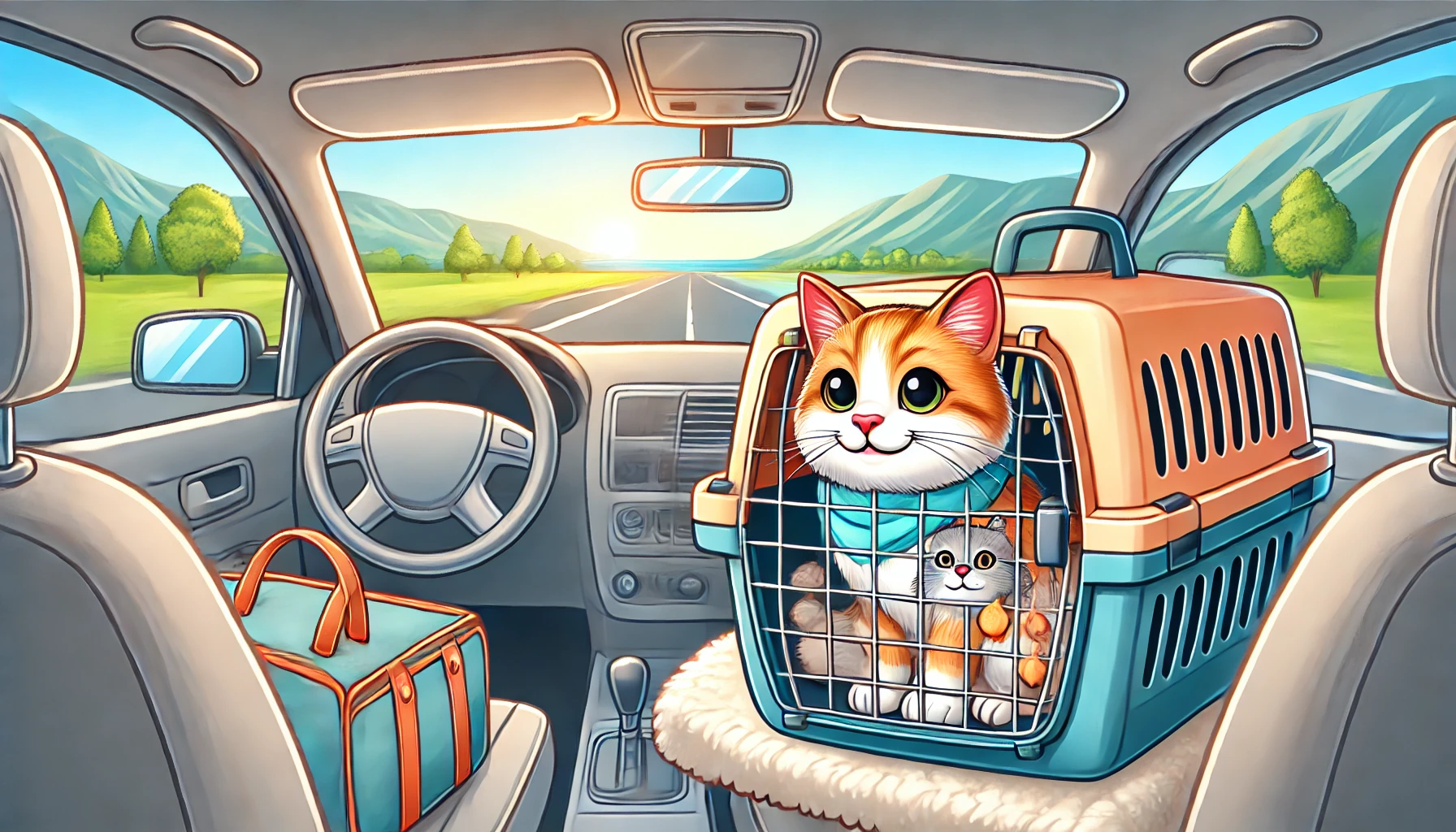
Conclusion on Keeping Cats Safe During Road Trips
While road trips with cats can be a great experience, ensuring the safety and comfort of your cat is key to a successful journey.
Every step, from preparing your cat before the trip to helping them settle in after arrival, is important in keeping your cat safe during road trips.
Following these guidelines will minimize stress for both you and your feline friend, making the road trip a positive experience.
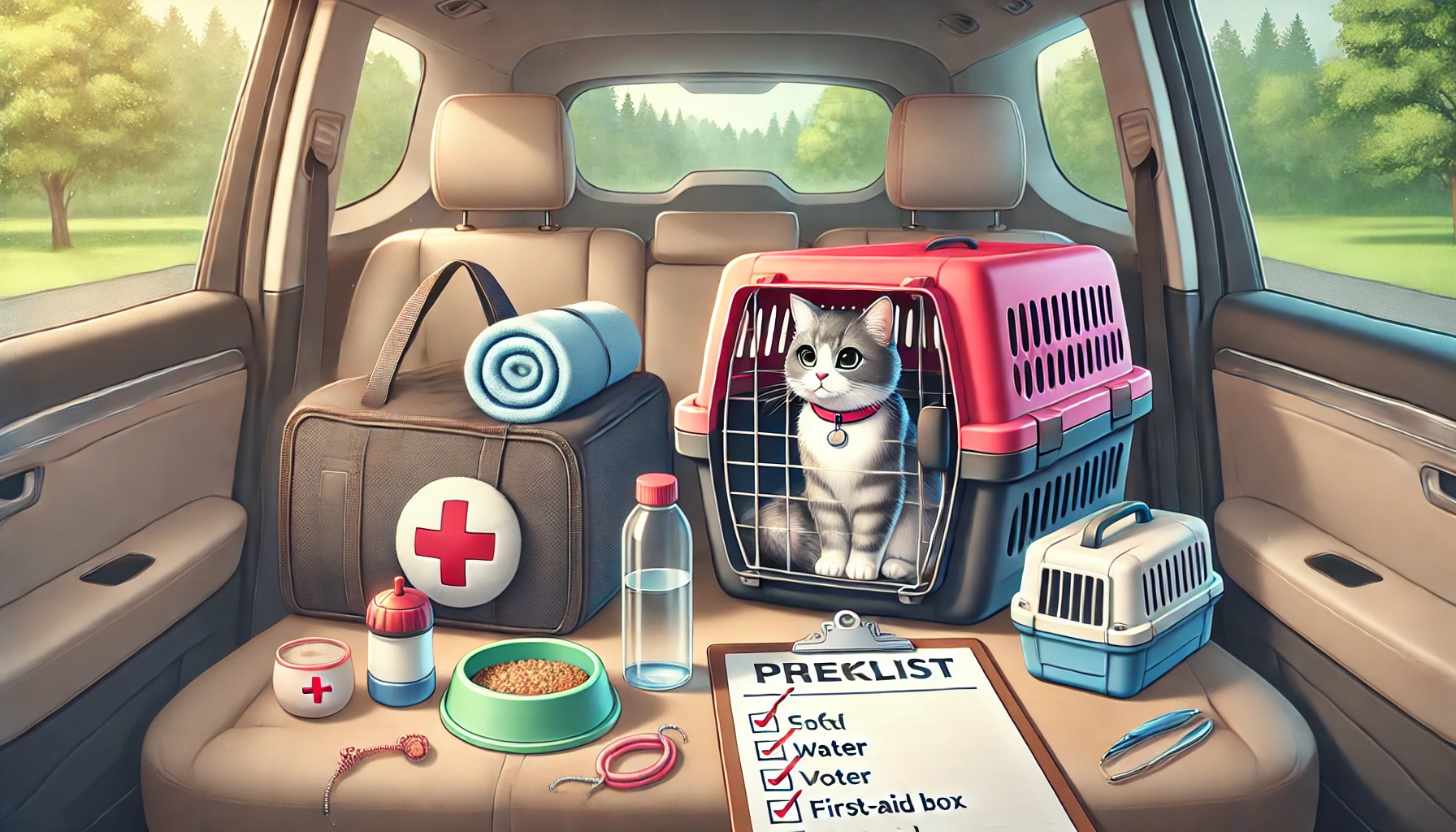
Preparation Is Key Towards a Safe Journey
As discussed, preparing your cat for the road trip is essential for a smooth and safe journey.
Choosing an appropriate carrier, familiarizing your cat with traveling, and conducting health checks before the trip are critical steps.
The more comfortable and ready your cat is, the less likely they are to feel stress or discomfort during the journey.
- Choose a well-ventilated and secure carrier: Ensure the carrier is comfortable for your cat.
- Familiarize your cat with the carrier: Take short trips in the carrier and reward your cat to help them get used to it.
- Bring essential items: Carry a portable litter box, water, and your cat’s favorite blanket for comfort.
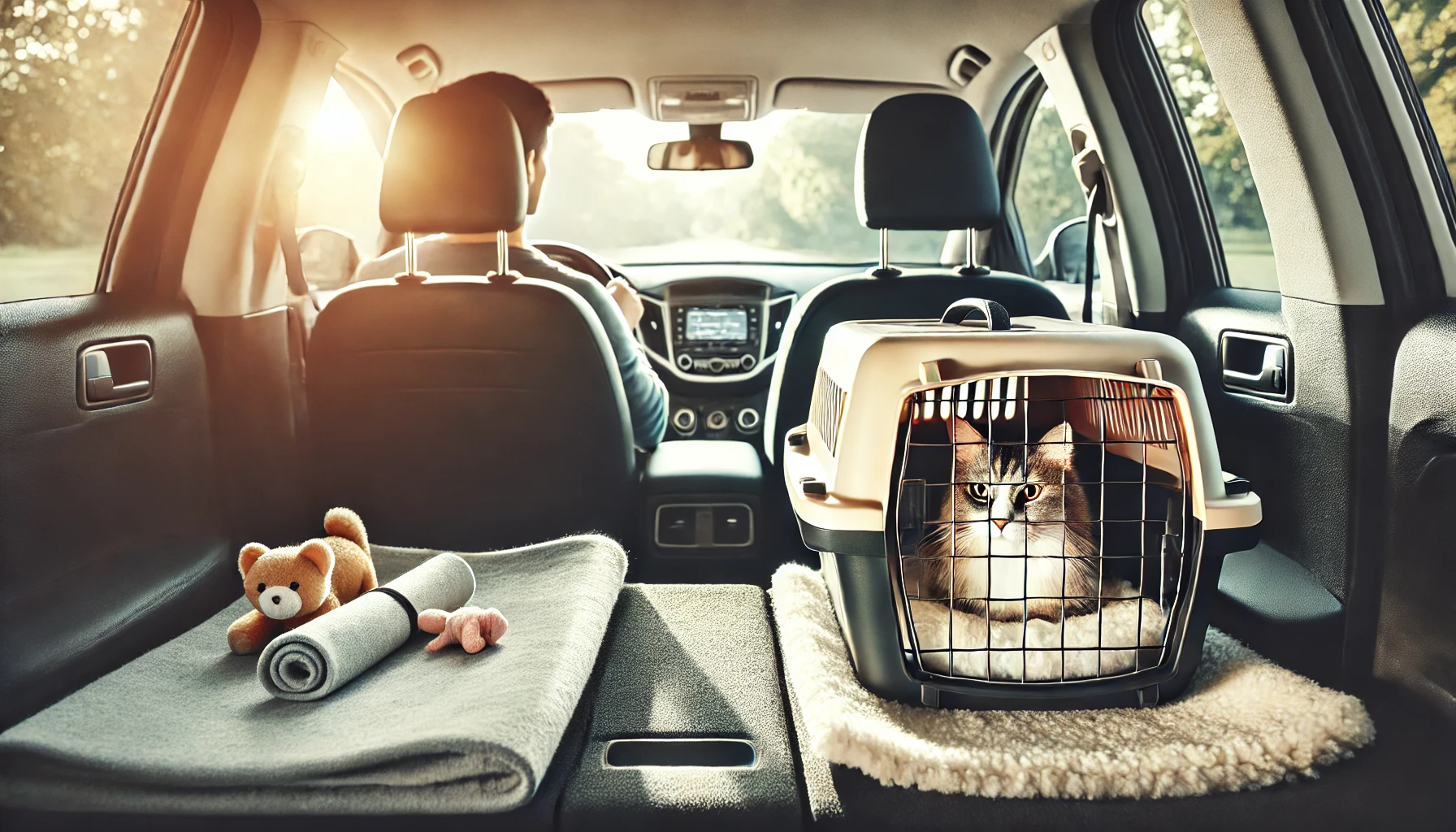
Creating Comfort During the Journey
During the trip, the interior of your car becomes the most important place to ensure your cat stays comfortable.
A secure carrier, proper ventilation, and controlled temperature are vital for keeping your cat safe and comfortable.
Additional comforts, such as calming products and regular breaks for hydration, help prevent motion sickness and stress.
- Fasten the carrier securely: Secure the carrier in the back seat to avoid sudden jolts.
- Maintain a comfortable temperature: Keep the car well-ventilated and at a suitable temperature for your cat.
- Use calming aids if needed: If your cat appears nervous, calming sprays or supplements may help.

After-the-Journey Care and Helping Your Cat Settle In
Once you arrive at your destination, your cat will need time to adjust to the new environment.
Providing fresh water and a light meal is a good start, followed by familiar routines to help your cat settle in.
Monitor your cat for any signs of stress or discomfort, and be patient as they adjust to their new surroundings.
- Create a quiet space: Set up a safe, quiet room where your cat can retreat and adjust at their own pace.
- Offer fresh water and a small meal: Help your cat rehydrate and recover from the journey.
- Maintain familiar routines: Stick to your cat’s usual feeding, play, and sleep schedules to provide comfort.
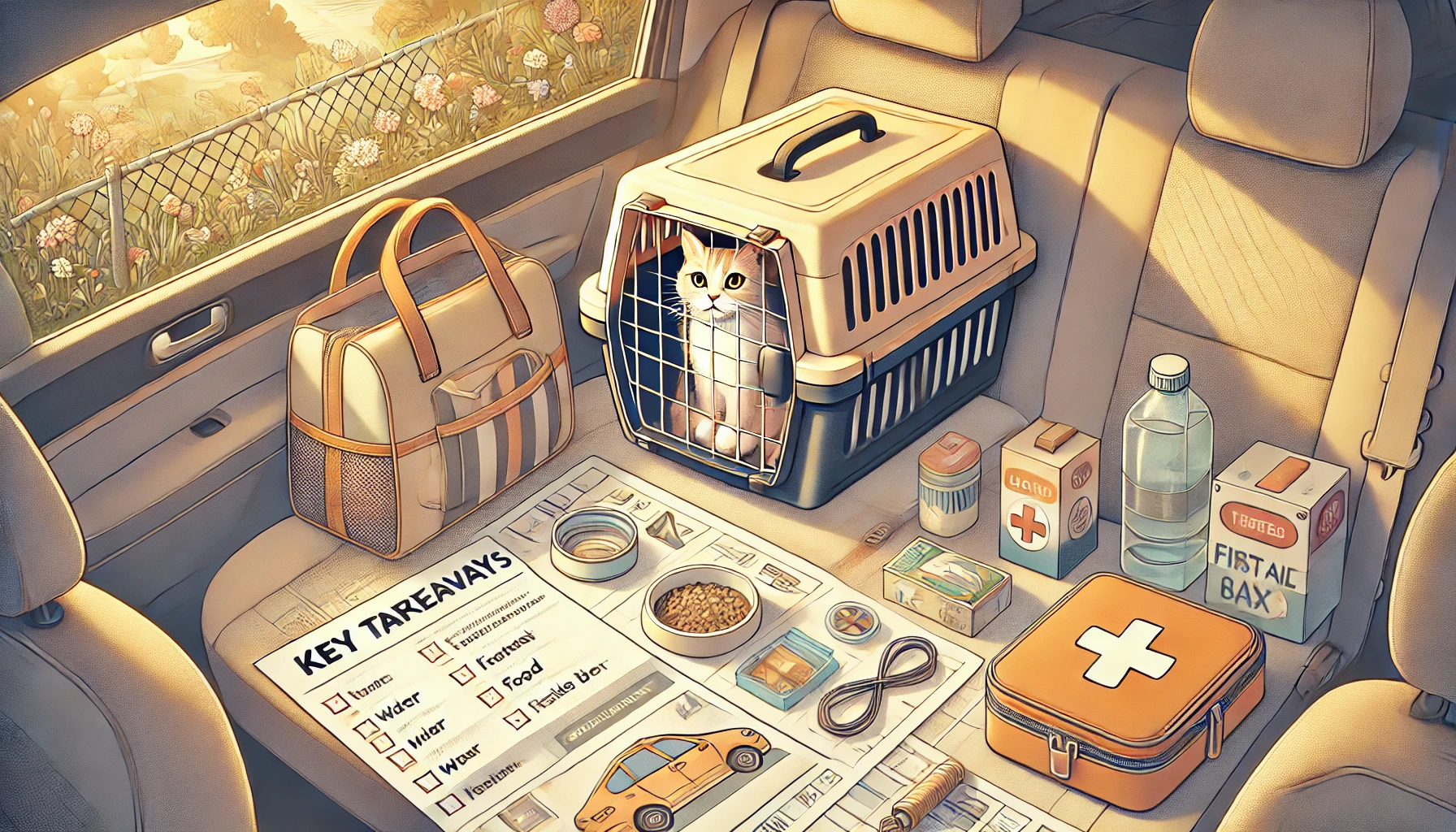
Key Takeaways for Keeping Cats Safe During Road Trips
In summary, keeping your cat safe on a road trip requires detailed preparation, attention to detail, and thoughtful care.
With the right precautions, road trips can be a great bonding experience with your cat while ensuring their well-being is your top priority.
Remember to plan ahead, take frequent breaks, and be attentive to your cat’s behavior.
Focusing on their safety and comfort will make the journey enjoyable and stress-free for both you and your feline passenger.
Preparation and care during the journey are key to a successful road trip with your cat. Keep safety, comfort, and stress reduction in mind throughout the journey.
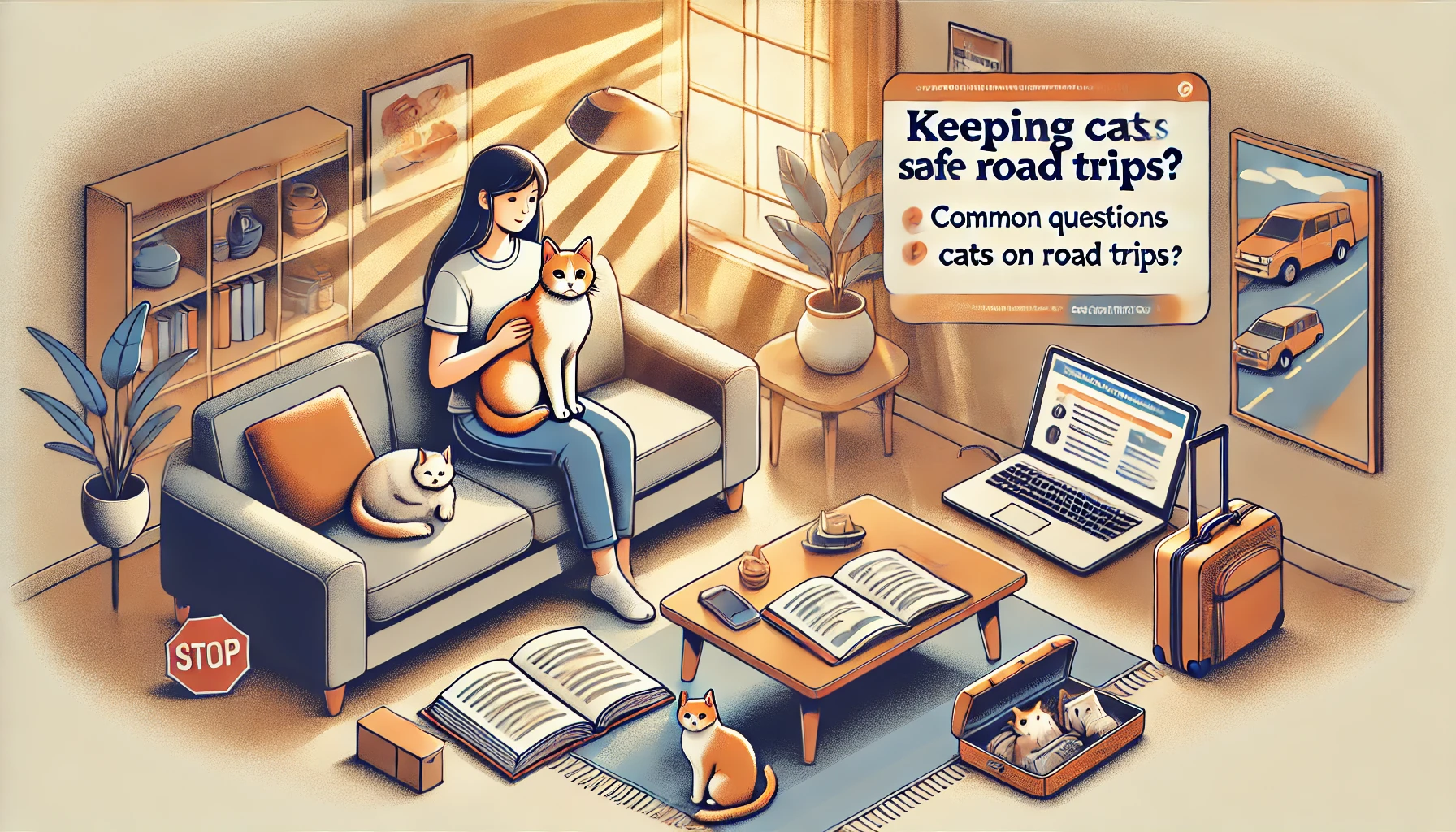
Frequently Asked Questions About Keeping Cats Safe on Road Trips
Some of the most frequently asked questions on how to keep a cat safe and comfortable during road trips are listed below.
These answers will help you be better equipped for your trip with your feline companion.
How can I help my cat stay calm during a road trip?
A safe carrier, familiar objects like toys or blankets, and calming sprays or supplements can help your cat.
Frequent stops and smooth driving also reduce stress, helping your cat feel more at ease during the trip.
How often should I stop during a long road trip with my cat?
It is advisable to stop every 2-4 hours during a long road trip to give your cat an opportunity to stretch, rehydrate, and use a portable litter box.
This helps keep your cat comfortable and hydrated.
What should I do if my cat gets motion sickness?
If your cat is prone to motion sickness, ensure the car is well-ventilated and drive smoothly.
You can also consult your vet for anti-nausea medication or try natural calming aids to help reduce symptoms during the trip.
How can I prepare my cat for a long road trip?
Allow your cat to get used to the carrier by taking short drives before the trip.
Pack essentials like water, litter, and toys, and check with your vet for a health review before your journey.
Is it safe to leave my cat alone in the car during stops?
No, you should never leave your cat alone in the car, especially in extreme weather.
Cars can quickly overheat or become too cold, putting your cat at risk of heatstroke or hypothermia.
What should I feed my cat during a road trip?
Feed your cat a small, light meal a few hours before traveling.
While on the road, offer small portions to avoid stomach upset, and provide fresh water throughout the trip.
Resume your cat’s usual feeding schedule after the trip.
What type of carrier is best for road trips?
A well-ventilated, comfortable carrier is ideal for car travel.
Choose one that allows your cat to stand, turn around, and lie down comfortably.
Ensure the carrier can be securely fastened in the car to prevent shifting.


